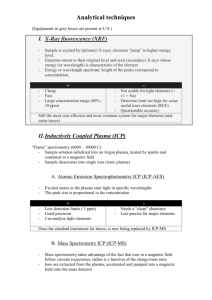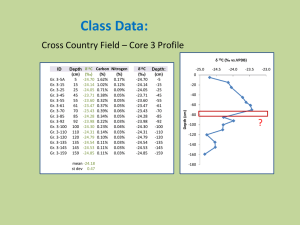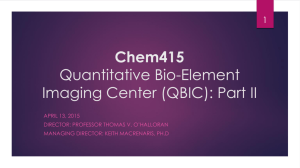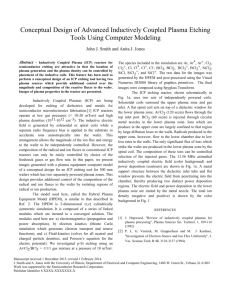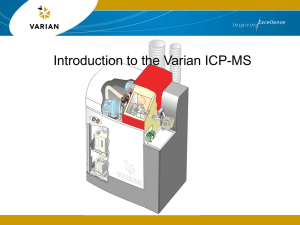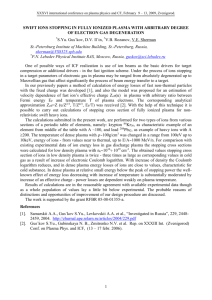Thermal Ionization MS
advertisement
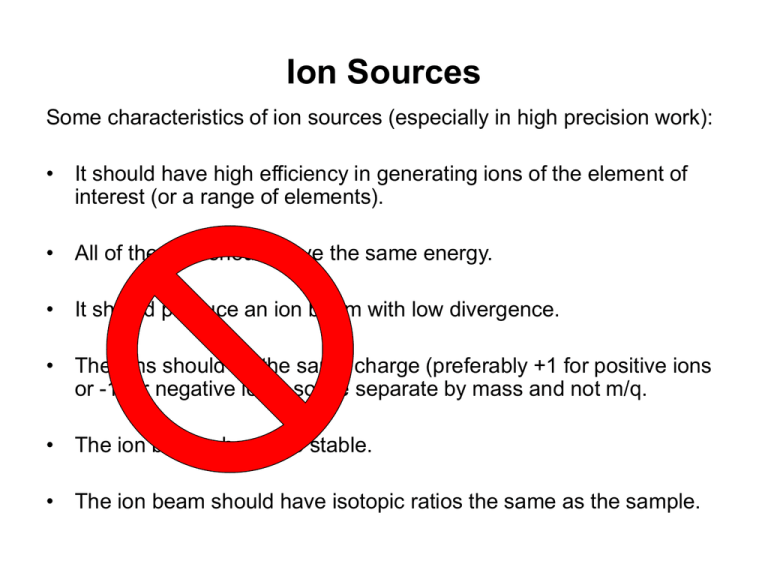
Ion Sources Some characteristics of ion sources (especially in high precision work): • It should have high efficiency in generating ions of the element of interest (or a range of elements). • All of the ions should have the same energy. • It should produce an ion beam with low divergence. • The ions should be the same charge (preferably +1 for positive ions or -1 for negative ions) so we separate by mass and not m/q. • The ion beam should be stable. • The ion beam should have isotopic ratios the same as the sample. Thermal Ionization MS Advantages – Extremely Stable – Generally less prone to isotopic fractionation effects than other sources – Thermalized ions (narrow energy range) Disadvantages – Complicated sample preparation – Incomplete isotope (elemental) coverage » Inconsistent positive or negative ionization efficiencies across periodic table Inductively Coupled Plasma MS Advantages – High sensitivity – Nearly complete isotope coverage – Liquid, solid or gas samples – Short analysis times – Less “art” Disadvantages – – – – – Isobaric interferences Relatively noisy Wide ion energy spread Inefficient Spectral complexity So what is the ICP? What equipment does it require? How does it operate? What are its features? How does it work with MS? Basic ICP Instrument Sample Introduction System ICP Spectrometric System Readout System Torch Inductively Coupled Plasma - Atomic Emission Spectrometry (ICP-AES) Nebulizer Spray Chamber 99% Types of ICP Nebulizers Concentric pneumatic Cross-flow pneumatic Ultrasonic (high sensitivity) High-solids (V-groove, Babington, etc.) ….. Types of ICP Spray Chambers Scott-type High-efficiency Cyclonic Desolvating ….. The Inductively Coupled Plasma A plasma is a hot, partially ionized gas. The ICP is an argon-based, radio frequency plasma. The input rf frequency is either 27 or 40 MHz at powers from 1 to 2 kW. The plasma is formed and contained in a three tube quartz touch. The temperature in the central analyte channel ranges from about 6000 to 8000° K. At these temperatures most elements are largely atomized and ionized The ICP Torch and Plasma THE STEPS THE STEPS ICP torch, nebulizer, spray chamber Inductively Coupled Plasma (ICP) YO Tail Flame Y+ Normal Analytical Zone Y e- + Ar Ar+ + 2e- Induction (Load) Coil Sample Aerosol Inductively Coupled Plasma (ICP) hν Mass Spectrometer Inductively Coupled Plasma Mass Spectrometry ICP-MS Interface Cones Supersonic Expansion YR YM Mach Disk Molecular Flow Barrel Shock YB 0.0000 ' XM Sampling Plate Transition Flow Continuum Flow X max Consequences of Expansion 5 KE Ar kT 2 Small ions Ar ions Large Ar Li Ar Ar Ar Ar Ar KE = 0.5 MV2 So KEM+ = kM+ Cs Plasma Offset (Rectification) + e- — Mass Spectrometer Plasma Offset (Rectification) — Mass Spectrometer + Ar+ Ion Energies Depend on Mass 27 MHz - open symbols 40 MHz - closed symbols - “hot” plasma - “cold” plasma Ion Currents in ICP-MS Spectral Characteristics of ICP-MS ICP-MS Background: 5% HCl ICP-MS Background: 5% H2SO4 Oxide and Hydroxide Species Variables Affecting Oxide Levels Matrix Induced Signal Changes Matrix Effects in ICP-MS ICP-MS Options for Isotope Ratios Multi-collector sector-field spectrometer – Offered by Thermo (Neptune), GV, and Nu – Isotope-ratio precision ~0.002% rsd (20 ppm) Time-of-flight mass spectrometer – Leco & GBC – Isotope-ratio precision ~0.05% rsd analog – Isotope-ratio precision ~0.01% rsd counting Array-detector sector field – Not yet commercially available – Isotope-ratio precision ~0.007% rsd Thermo Neptune MC-ICP-MS Nu Instruments MC-ICP-MS Leco Renaissance ICP-TOFMS GBC Optimass ICP-TOFMS
